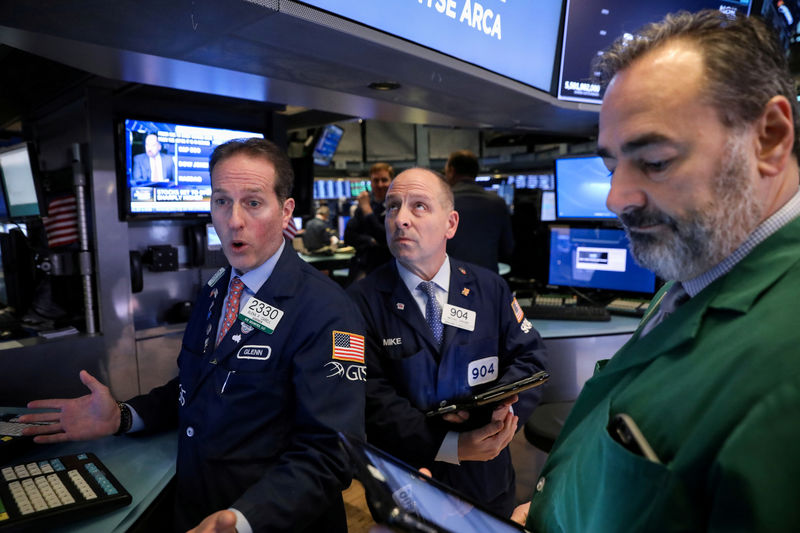 © Reuters. FILE PHOTO: Traders work on the floor of the NYSE in New York
© Reuters. FILE PHOTO: Traders work on the floor of the NYSE in New York(Reuters) – Following are five big themes likely to dominate thinking of investors and traders in the coming week and the Reuters stories related to them.
1/BREXIT MAY DAY
With less than 80 days to go until Britain leaves the European Union, the path to Brexit winds to a critical crossroads on Tuesday when lawmakers vote on Prime Minister Theresa May’s withdrawal deal. The agreement, which May and EU leaders say cannot be renegotiated and is the only one available, will almost certainly be rejected. If so, uncertainty, paralysis and the likelihood of a disorderly ‘no deal’ Brexit will rise.
Volatility is nothing new to sterling, Friday being a microcosm of how the FX market is playing Brexit. A media report that Britain’s departure could be delayed sent the pound shooting up nearly a cent to its highest since Nov. 29, then minutes later May’s spokeswoman ruled out any delay and the pound fell right back again. One-month implied options volatility in sterling is much higher than euro vol, and that’s unlikely to change any time soon. All eyes on the big vote in Parliament on Tuesday and for sterling, moves below $1.25 or above $1.30 are both on the table.
(GRAPHIC: Sterling volatility – https://tmsnrt.rs/2SN1jm3)
2/PRICE PRESSURE
The Fed reckons the world’s biggest economy is continuing to motor ahead but markets seem to think otherwise, their fears for the growth outlook knocking equity prices off record highs. More recently though they have cheered Fed Chairman Jerome Powell’s comment that the U.S. central bank can be patient in approving any further rate increases. Powell said that “especially with inflation low and under control”, the Fed can “be patient and watch patiently” to figure out which of the two competing narratives unfolds in 2019.
So whose view is correct? It’s true labour markets are robust and wage inflation has been on the rise — average earnings rose in December by 3.2 percent on an annual basis, matching October’s rise which was a 9-1/2-year high. But workers’ wage gains are also being eroded by inflation, with core CPI seen above the Fed’s 2 percent target in coming months. Powell’s newly dovish-sounding rhetoric has prompted money markets to price out Fed rate rises in 2019 but the producer price index due Jan 15 could be key. If it shows inflationary pressures cooling, there could be a further reprieve from markets’ rate-hike concerns.
(GRAPHIC: Can Powell’s Fed afford to be “patient”? https://tmsnrt.rs/2H6xfAE)
3/EARN, BABY, EARN
Global stock markets have suffered in recent weeks on fears that economic growth — and company earnings — are on the decline. Upcoming U.S. company earnings will test this view.
Big U.S. hitters due to issue fourth-quarter results next week include Micron Technology (NASDAQ:), Netflix (NASDAQ:), and major Wall Street banks Citi, JPMorgan (NYSE:) and Wells Fargo (NYSE:). Money has started trickling back into equity funds this week thanks to Powell’s dovish comments. But earnings expectations remain low nevertheless: I/B/E/S Refinitive data indicates earnings will have grown 14.5 percent in the fourth quarter of 2018, the slowest since Q3 2017, sharply lower than the 28.4 percent rise in Q3 2018 and almost flat year-on-year.
And confidence in Europe is even lower — earnings-per-share (EPS) for companies is expected to have grown 7.1 percent in Q4, half levels seen in Q3 and Q4 2017. Forecasts as recently as November were for 14 percent growth but a spate of nasty macro-economic surprises has caused analysts to downgrade their view.
Some strategists do reckon markets have got ahead of themselves by pricing in a growth slowdown or recession. Company results could show who’s getting it right.
(GRAPHIC: U.S. vs Europe valuations – https://tmsnrt.rs/2H5O4vx)
(GRAPHIC: Citi Economic Surprise Indicator – https://tmsnrt.rs/2H5OzWr)
4/SHIPPING NEWS
China and the United States have held their first face-to-face talks since the two world powers agreed a 90-day trade war truce. Described as “extensive”, the talks have helped cheer up global equity investors. But risk aversion could rear its head again should hard data from China show what damage has been done to the economy by the initial tariff rounds.
In particular focus will be Chinese export growth. Analysts expect that to have cooled for a second month in December as front-loading of U.S.-bound cargoes faded. Poor data will be another incentive for Beijing to be more accommodative with fiscal and monetary policies. It has already engaged a reserve ratio cut for banks which should pump the equivalent of $115 billion into the economy. What remains to be seen is how accommodative it might be with U.S. demands on trade.
(GRAPHIC: China policy easing – https://reut.rs/2mF5iTc https://reut.rs/2mF5iTc)
5 TURKEY’S RE-BALANCING ACT
Having just suffered its worst year in the best part of two decades, the Turkish lira’s had a tumultuous start to 2019. It’s weakened more than 2 percent year-to-date and worse still, it experienced a flash crash on Jan. 3, which was a reminder of all its vulnerabilities: from geopolitics to upcoming elections and haphazard monetary policy.
On the positive side, the lira’s near-30 percent tumble in 2018 had got rebalancing off to a fast start; Turkey is now posting large current account surpluses and inflation, albeit high, is on the decline. But many worry that these very factors could tempt the central bank back onto the interest rate-cutting path. On Wednesday, at its first meeting of 2019, the central bank is expected to stand pat, with 17 out of 19 economists seeing key rates steady at 24 percent. But two predicted a cut and the bank’s own survey finds that Turkish interest rates are seen falling almost 500 basis points in the coming year.
The picture is less dramatic in South Africa which is seen leaving interest rates unchanged at 6.75 percent on Thursday, with rising inflation likely prompting a rate hike in May.
(GRAPHIC: Turkey interest rate & inflation – https://tmsnrt.rs/2SLpzoE)
Source: Investing.com





























